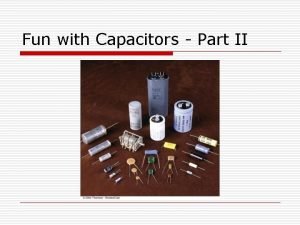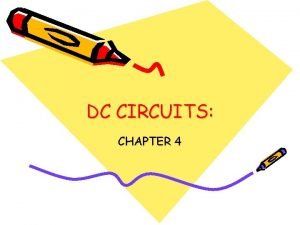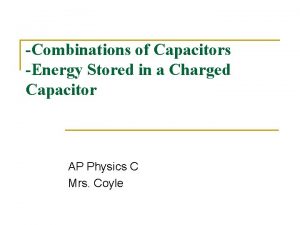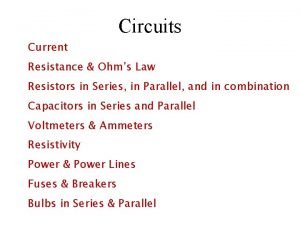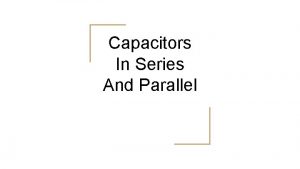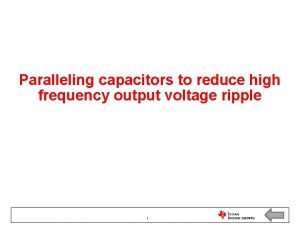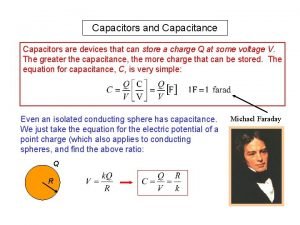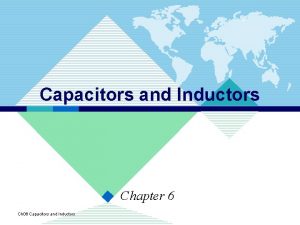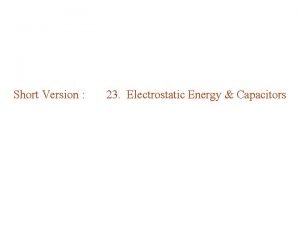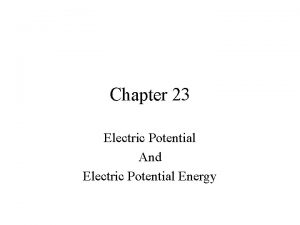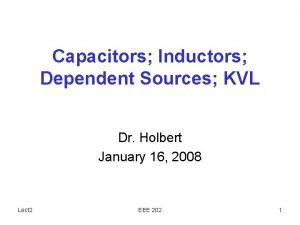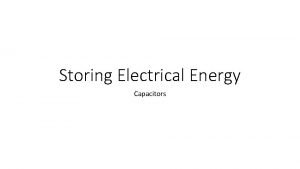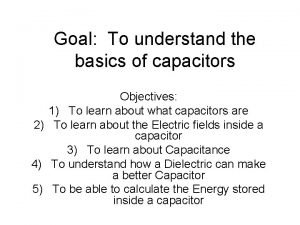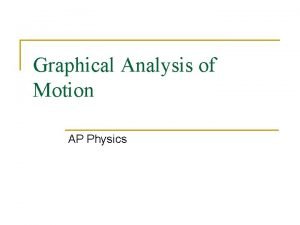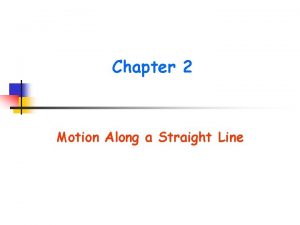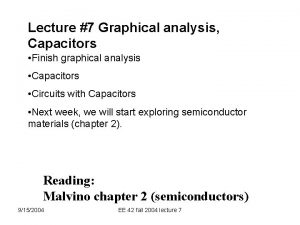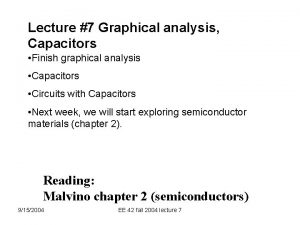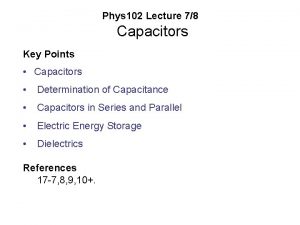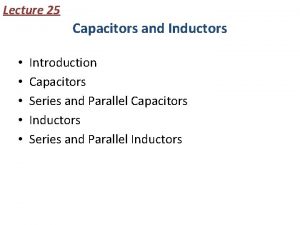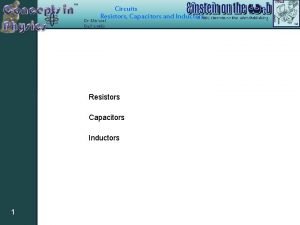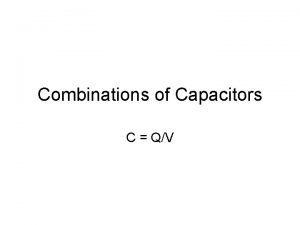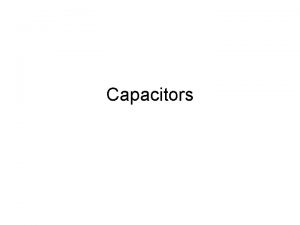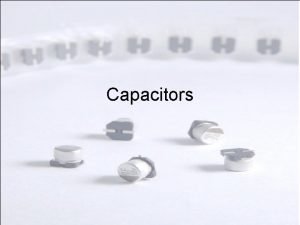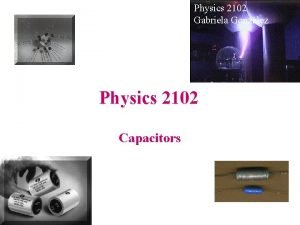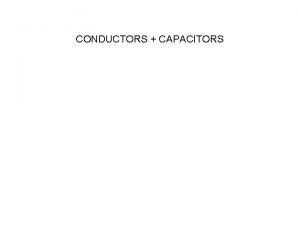Lecture 7 Graphical analysis Capacitors Finish graphical analysis

















- Slides: 17

Lecture #7 Graphical analysis, Capacitors • Finish graphical analysis • Capacitors • Circuits with Capacitors • Next week, we will start exploring semiconductor materials (chapter 2). Reading: Malvino chapter 2 (semiconductors) 9/15/2004 EE 42 fall 2004 lecture 7

Power of Load-Line Method We have a circuit containing a two-terminal non-linear element “NLE”, and some linear components. The entire linear part of the circuit can be replaced by an equivalent, for example the Thevenin equivalent. This equivalent circuit consists of a voltage source in series with a resistor. (Just like the example we just worked!). So if we replace the entire linear part of the circuit by its Thevenin equivalent our new circuit consists of (1) a non-linear element, and (2) a simple resistor and voltage source in series. If we are happy with the accuracy of graphical solutions, then we just graph the I vs V of the NLE and the I vs V of the resistor plus voltage source on the same axes. The intersection of the two graphs is the solution. (Just like the problem on page 6) 9/15/2004 EE 42 fall 2004 lecture 7

The Load-Line Method We have a circuit containing a two-terminal non-linear element “NLE”, and some linear components. First replace the entire linear part of the circuit by its Thevenin equivalent (which is a resistor in series with a voltage source). We will learn how to do this in Lecture 11. Then define I and V at the NLE terminals (typically associated signs) D Nonlinear 9 m. A element S 9/15/2004 D 250 K 1 M + - 1 V N L E EE 42 fall 2004 lecture 7 ID + VDS + 200 K 2 V S -

Example of Load-Line method (con’t) Given the graphical properties of two terminal non-linear circuit (i. e. the graph of a two terminal device) And have this connected to a linear (Thévenin) circuit D N L E Whose I-V can also be graphed on the same axes (“load line”) S 9/15/2004 + - 200 K 2 V The intersection gives circuit solution ID (m. A) D ID VDS+ + VDS S ID 10 + - The solution ! 200 K 2 V EE 42 fall 2004 lecture 7 1 2 VDS (V)

Load-Line method The method is graphical, and therefore approximate But if we use equations instead of graphs, it could be accurate It can also be use to find solutions to circuits with three terminal nonlinear devices (like transistors), which we will do in a later lecture ID (m. A) D ID S 9/15/2004 10 + - The solution ! 200 K 2 V EE 42 fall 2004 lecture 7 1 2 VDS (V)

Power Calculation Review Power is calculated the same way for linear and non-linear elements and circuits. For any circuit or element the dc power is I X V and, if associated signs are used, represents heating (or charging) for positive power or extraction of energy for negative signs. For example in the last example the NLE has a power of +1 V X 5 m. A or 5 m. W. It is absorbing power. The rest of the circuit has a power of - 1 V X 5 m. A or - 5 m. W. It is delivering the 5 m. W to the NLE. So what it the power absorbed by the 200 K resistor? Answer: I X V is + 5 m. A X (5 m. A X 200 K) = 5 m. W. Then the voltage source must be supplying a total of 10 m. W. Can you show this? 9/15/2004 EE 42 fall 2004 lecture 7

Storing charge • If you try to store charge on a piece of metal, like a Van de Graaff generator, the work required to put more and more charge on the piece of metal gets very large, and thus the voltage gets high fast. + + + 9/15/2004 EE 42 fall 2004 lecture 7 +

Capacitor • If you want to store more charge, at less voltage, then you can put two plates of metal close together, and store positive charge on one, and negative charge on the other. ------- ++++++ 9/15/2004 EE 42 fall 2004 lecture 7

Capacitance • The voltage is proportional to the charge which is stored on the plates • +Q on one • -Q on the other • Current is the flow of charge per unit time • Since charge is proportional to voltage, we define a proportionality constant C called the Capacitance 9/15/2004 EE 42 fall 2004 lecture 7

Capacitance of parallel plates • The bigger the area of two plates which are close together, the more charge they can hold for a given voltage (proportionally) • The further apart, the bigger the voltage is for the same charge. (also proportional) The variable ε is a property of the material, called the dielectric constant 9/15/2004 EE 42 fall 2004 lecture 7

Capacitors • A battery is a complex device, chemical reactions generate current (charges) as needed to maintain the voltage • A capacitor is a much simpler device, it just stores charge by keeping positive charges close to the negative charges on separate conductors • As charge is added, the repulsion and therefore the voltage increases • As charge is removed, the voltage drops 9/15/2004 EE 42 fall 2004 lecture 7

CAPACITORS +V |( i(t) C capacitance is defined by 9/15/2004 EE 42 fall 2004 lecture 7

CAPACITORS IN SERIES + Veq + V 1 + V 2 |( |( C 1 C 2 i(t) |( Equivalent to i(t) Equivalent capacitance defined by Clearly, 9/15/2004 EE 42 fall 2004 lecture 7 Ceq

CAPACITORS IN PARALLEL + C 2 |( C 1 |( i(t) V i(t) Clearly, 9/15/2004 EE 42 fall 2004 lecture 7 Ceq |( Equivalent capacitance defined by + V(t)

Charging a Capacitor with a constant current + V(t) |( i 9/15/2004 C EE 42 fall 2004 lecture 7

Discharging a Capacitor through a resistor V(t) i + C i R This is an elementary differential equation, whose solution is the exponential: Since: 9/15/2004 EE 42 fall 2004 lecture 7

Voltage vs time for an RC discharge Voltage Time 9/15/2004 EE 42 fall 2004 lecture 7
 01:640:244 lecture notes - lecture 15: plat, idah, farad
01:640:244 lecture notes - lecture 15: plat, idah, farad Fun with capacitors
Fun with capacitors Inductors in dc circuits
Inductors in dc circuits Voltage across capacitors in series
Voltage across capacitors in series Resistor in series and parallel
Resistor in series and parallel Series and parallel capacitors
Series and parallel capacitors Paralleling capacitors
Paralleling capacitors Energy stored in capacitor formula
Energy stored in capacitor formula 6-25
6-25 Electrostatic energy
Electrostatic energy Energy stored in capacitors
Energy stored in capacitors Kvl with capacitors
Kvl with capacitors Energy stored in capacitor
Energy stored in capacitor Flat ppr
Flat ppr The basics of capacitors
The basics of capacitors Graphical and numerical methods
Graphical and numerical methods Graphical analysis of motion
Graphical analysis of motion Kinematics motion along a straight line
Kinematics motion along a straight line

